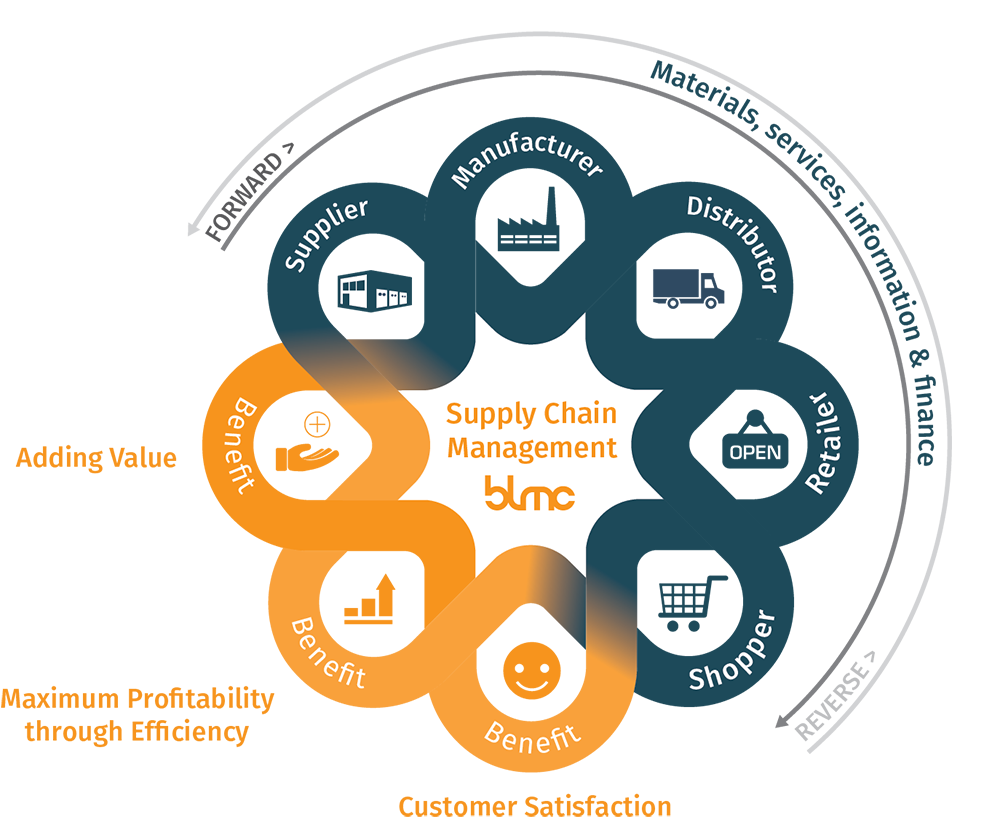What is supply chain management?
Lower prices, more profit, on-time deliveries, wider product diversity, more innovations, stronger customer focus, better ability to cope with fluctuating volumes, less waste and downtime, and shorter customer response times – is this a pipe dream? No, it’s supply chain management..
We work with the following definition of supply chain management (SCM):
“The management of a network of relationships within a firm and between interdependent organisations and business units consisting of material suppliers, purchasing, production facilities, logistics, marketing, and related systems that facilitate the forward and reverse flow of materials, services, finances and information from the original producer to final customer with the benefits of adding value, maximizing profitability through efficiencies, and achieving customer satisfaction’’ (Stock & Boyer, 2009)
About supply chain management
Supply chain management is about everything related to an organization’s inbound and outbound flows. In this context, we can make a distinction between the internal and external supply chain:
- The internal supply chain entails everything within your organization and is related to purchasing, production, storage and sales
- The external supply chain entails everything outside of your organization and is related to suppliers, customers and other stakeholders.

In effect, the supply chain extends from raw input right through to the output to the ultimate end user, i.e. ‘from farm to fork’. In other words, the supply chain starts with the companies that obtain raw materials and ends with the link in the chain that supplies the finished product to the end user.
The supply chain management activities therefore affect various roles both within and outside of the organization. This wide reach underlines how difficult implementation can be, often presenting highly complex problems and challenges, not least in terms of the communication between all the stakeholders at various levels within and between organizations.
Experience has shown that conflicting interests and everyday disagreements at strategic, operational and tactical level are very time-consuming – and that time would be better spent on improving the success of the supply chain. In the literature, supply chain management is widely recognized and advocated as a successful approach. In practice, however, it is still a young and immature discipline in which it is very much a case of trial and error.
Why supply chain management?
If the supply chain plays a crucial role in the success of a company, supply chain management (SCM) is essential. Let’s just think about the inbound and outbound flows, for example. On average, the purchasing costs account for 60% of a product’s cost price, and logistics costs account for 25% of an organization’s total costs.
Supply chain management enables you to identify and eliminate bottlenecks so that you can reduce these costs and improve the company’s financial performance. Furthermore, effective use of supply chain management enables organizations to respond to – and capitalize on – inevitable and fast-paced changes.
Supply chain management means collaboration
Collaboration between all the partners in the supply chain is extremely important if supply chain management is to be implemented effectively, but this often leaves a lot to be desired in practice. This is due to conflicting interests within the supply chain, such as between Purchasing, Logistics, Sales, Production and Planning internally, or between suppliers and customers externally.
The first step in safeguarding collaboration is to formulate a strategy. This simply entails agreeing shared objectives and indicating how those objectives can be achieved. A strategy enables organizations to work as a team.
“However, there are still too many cases of everyone doing their own thing in practice – much to the frustration of the supply chain manager, who is typically a strong team player,” comments Professor Jack van der Veen from Nyenrode Business Universiteit.

